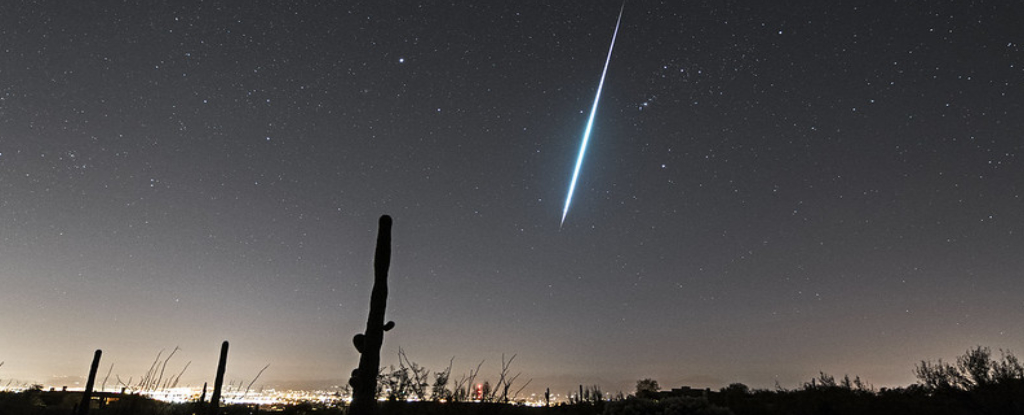Key Takeaways:
I. 3200 Phaethon, the Geminids' parent body, is a unique 'rock-comet' exhibiting characteristics of both asteroids and comets, challenging traditional classifications.
II. The Geminid meteor shower provides valuable scientific data for understanding meteoroid stream dynamics, planetary defense, and potential asteroid resource utilization.
III. The DESTINY+ mission's planned flyby of Phaethon will provide crucial data for understanding 'rock-comets,' informing future space missions and resource prospecting.
The Geminid meteor shower, an annual celestial event peaking around December 13-14, offers skywatchers a dazzling display of shooting stars. But beyond the visual spectacle, the Geminids hold significant scientific value, providing insights into the enigmatic 'rock-comet' 3200 Phaethon, the shower's unique parent body. This article delves into the science behind the Geminids, exploring Phaethon's unusual properties, the dynamics of the meteor stream, and the upcoming DESTINY+ mission that promises to unlock further secrets.
Unraveling the Mysteries of Phaethon
3200 Phaethon stands out in the solar system as a 'rock-comet,' an object blurring the lines between asteroids and comets. Its highly elliptical orbit brings it closer to the Sun (0.14 AU) than any other named asteroid, subjecting its surface to extreme temperatures reaching 750°C. This intense heating plays a crucial role in the creation of the Geminid meteor shower.
Unlike the majority of asteroids, which appear reddish or gray, Phaethon exhibits a surprising blue color. This unusual coloration, combined with its comet-like dust ejection, suggests a unique composition and formation history. Scientists believe the blue hue may result from the sublimation of surface materials due to intense solar heating, leaving behind a different spectral signature.
Table summarizing the key orbital and physical characteristics of asteroid 3200 Phaethon, believed to be the parent body of the Geminid meteor shower. Note: Some parameters may vary slightly depending on the source and epoch of observation. Data compiled from multiple sources including NASA JPL.
The dust that forms the Geminid meteor stream originates from Phaethon's surface. The extreme temperature variations during its orbit likely cause thermal fracturing and rotational breakup, releasing dust particles into space. This process, combined with the influence of solar radiation pressure, creates the stream that Earth encounters annually, producing the dazzling Geminid meteor shower.
Studying Phaethon provides a unique opportunity to understand the early solar system. Its 'rock-comet' nature suggests a complex evolutionary path, potentially involving processes not typically associated with asteroids. By analyzing its composition and behavior, scientists can gain valuable insights into the diverse population of objects that formed alongside planets and the conditions that prevailed during the solar system's infancy.
The Geminid Meteor Shower: Tips for Optimal Viewing
The Geminids are known for their intensity, with a Zenithal Hourly Rate (ZHR) of 120. This means that under ideal conditions – a perfectly dark sky with the radiant directly overhead – an observer could theoretically see up to 120 meteors per hour. However, the near-full moon in December 2024 will significantly reduce visibility, making fainter meteors more challenging to observe.
To maximize your Geminid viewing experience, careful planning is essential. Find a location far from city lights, minimizing light pollution. Position yourself so that the moon is behind you or at a significant angle from the radiant point in the constellation Gemini. Allow your eyes to adapt to the darkness for at least 20 minutes, and dress warmly for the December chill.
The Geminid stream is not a uniform cloud of dust but a complex structure shaped by gravitational interactions with planets, particularly Jupiter. Earth's passage through different filaments within the stream can result in varying meteor counts from year to year. These filaments, regions of higher dust density, create the peaks and lulls in meteor activity during the shower.
While most Geminid meteoroids are small and burn up harmlessly in the atmosphere, the stream also contains larger particles. Tracking these larger meteoroids and understanding their trajectories is a key aspect of planetary defense. Ongoing monitoring and advanced modeling techniques help scientists assess potential impact risks and develop mitigation strategies, safeguarding Earth from cosmic threats.
Probing Phaethon: The Science and Technology of DESTINY+
The DESTINY+ mission, developed by the Japanese Aerospace Exploration Agency (JAXA), is poised to revolutionize our understanding of 3200 Phaethon. Scheduled for launch no earlier than 2028, this spacecraft will perform a high-speed flyby of the rock-comet, collecting crucial data on its surface composition, dust environment, and rotational dynamics. This close encounter will provide unprecedented insights into Phaethon's enigmatic nature.
The scientific data collected by DESTINY+ will have far-reaching implications. Analyzing Phaethon's composition could reveal valuable resources, informing future asteroid mining efforts. The mission's findings will also be essential for advancing spacecraft design, particularly in developing robust dust shielding and navigation systems for operating in extreme environments near the Sun. This knowledge will be invaluable for future missions to asteroids and other challenging destinations in our solar system.
The Geminids: A Continuing Source of Wonder and Scientific Discovery
The Geminid meteor shower, a yearly spectacle of cosmic proportions, offers a unique blend of wonder and scientific discovery. From the enigmatic 'rock-comet' 3200 Phaethon to the dynamics of the meteor stream itself, the Geminids provide a window into the complex processes that have shaped our solar system. As we look up in awe at the shower's fiery trails, let us also appreciate the ongoing scientific quest to unravel its secrets, a quest that promises to expand our understanding of the cosmos and inspire future generations of explorers. By observing the Geminids and supporting missions like DESTINY+, we become active participants in this grand cosmic journey.

